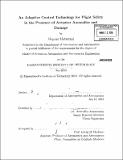| dc.contributor.advisor | Anuradha Annaswamy. | en_US |
| dc.contributor.author | Matsutani, Megumi | en_US |
| dc.contributor.other | Massachusetts Institute of Technology. Dept. of Aeronautics and Astronautics. | en_US |
| dc.date.accessioned | 2010-08-30T14:39:17Z | |
| dc.date.available | 2010-08-30T14:39:17Z | |
| dc.date.copyright | 2010 | en_US |
| dc.date.issued | 2010 | en_US |
| dc.identifier.uri | http://hdl.handle.net/1721.1/57692 | |
| dc.description | Thesis (S.M.)--Massachusetts Institute of Technology, Dept. of Aeronautics and Astronautics, 2010. | en_US |
| dc.description | Cataloged from PDF version of thesis. | en_US |
| dc.description | Includes bibliographical references (p. 73-74). | en_US |
| dc.description.abstract | The challenge of achieving safe flight comes into sharp focus in the face of adverse conditions caused by faults, damage, or upsets. When these situations occur, the corresponding uncertainties directly affect the safe operation of the aircraft. A technology that has the potential for enabling a safe flight under these adverse conditions is adaptive control. One of the main features of an adaptive control architecture is its ability to react to changing characteristics of the underlying aircraft dynamics. This thesis proposes the building blocks of an adaptable and reconfigurable control technology that ensures safe flight under adverse flight conditions. This technology enables the synthesis of such controllers as well as the systematic evaluation of their robustness characteristics. The field of adaptive control is a mature theoretical discipline that has evolved over the past thirty years, embodying methodologies for controlling uncertain dynamic systems with parametric uncertainties [1, 2, 3, 4, 5, 6]. Through the efforts of various researchers over this period, systematic methods for the control of linear and nonlinear dynamic systems with parametric and dynamic uncertainties have been developed [7, 8, 9, 10, 11, 12]. Stability and robustness properties of these systems in the presence of disturbances, time-varying parameters, unmodeled dynamics, time-delays, and various nonlinearities, have been outlined in the references [4]-[13] as well as in several journal and conference papers over the same period. | en_US |
| dc.description.abstract | (cont.) In this thesis, we consider the control of a transport aircraft model that resembles the Generic Transport Model [14]. While the vehicles' geometry and aerodynamic model are those of a C5 aircraft, every other aspect has been made to coincide with the GTM, e.g. anti wind-up logic, time-delay due to telemetry, baseline control structure, low-pass and wash-out filters. We delineate the underlying nonlinear model of this aircraft, and introduce various damages, and failures into this model. An adaptive control architecture is proposed which combines a nominal controller that provides a satisfactory performance in the absence of adverse conditions, and an adaptive controller that is capable of accommodating various adverse conditions including actuator saturation. The specific adverse conditions considered can be grouped into the following three categories, (a) upsets, (b) damages, and (c) actuator failures. Specific cases in (a) include flight upsets in initial conditions of various states including angle of attack, cases in (b) include situations where structural failures cause changes in the location of the Center-of-Gravity (CG)[15], while cases in (c) include situations where symmetric and asymmetric failures in control surfaces and engines occur. These failures include losses in control effectiveness, and locked-in-place control surface deflections. The resilience of the adaptive controller to uncertainty is evaluated for safety using the control verification methodology proposed in [16]. | en_US |
| dc.description.abstract | (cont.) This methodology enables the determination of ranges of uncertainty for which a prescribed set of closed-loop requirements are satisfied. This thesis studies several one-dimensional uncertainty analyzes for two flight maneuvers that focus on the longitudinal and lateral dynamics. As compared to the baseline controller, the adaptive controller enlarges the region of safe operation by a sizable margin in all but one of the cases considered. | en_US |
| dc.description.statementofresponsibility | by Megumi Matsutani. | en_US |
| dc.format.extent | 74 p. | en_US |
| dc.language.iso | eng | en_US |
| dc.publisher | Massachusetts Institute of Technology | en_US |
| dc.rights | M.I.T. theses are protected by
copyright. They may be viewed from this source for any purpose, but
reproduction or distribution in any format is prohibited without written
permission. See provided URL for inquiries about permission. | en_US |
| dc.rights.uri | http://dspace.mit.edu/handle/1721.1/7582 | en_US |
| dc.subject | Aeronautics and Astronautics. | en_US |
| dc.title | An adaptive control technology for flight safety in the presence of actuator anomalies and damage | en_US |
| dc.type | Thesis | en_US |
| dc.description.degree | S.M. | en_US |
| dc.contributor.department | Massachusetts Institute of Technology. Department of Aeronautics and Astronautics | |
| dc.identifier.oclc | 639254470 | en_US |
